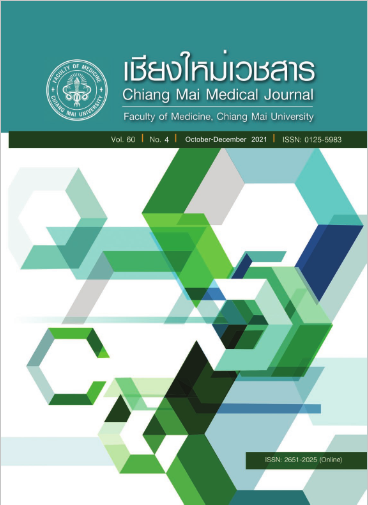การจัดการเพื่อได้รับยาปฏิชีวนะในผู้ป่วยติดเชื้อในกระแสเลือดที่หน่วยตรวจฉุกเฉิน: การวิเคราะห์สถานการณ์
Main Article Content
บทคัดย่อ
วัตถุประสงค์ เพื่อศึกษาสถานการณ์การจัดการเพื่อได้รับยาปฏิชีวนะในผู้ป่วยติดเชื้อในกระแสเลือดที่หน่วยตรวจฉุกเฉิน โรงพยาบาลระดับ ตติยภูมิ
วิธีการ การวิจัยครั้งนี้เป็นการศึกษาย้อนหลังเชิงพรรณนา (retrospective descriptive study) โดยใช้แนวคิดของโดนาบีเดียน (Donabedian, 2002) มาเป็นกรอบในการศึกษาสถานการณ์การจัดการเพื่อได้รับยาปฏิชีวนะในผู้ป่วยติดเชื้อในกระแสเลือด ในหน่วยตรวจฉุกเฉิน โดยศึกษาองค์ประกอบในการดูแล 3 องค์ประกอบ คือ ด้านโครงสร้าง ด้านกระบวนการ และด้านผลลัพธ์ ศึกษาในกลุ่มตัวอย่าง 2 กลุ่ม ได้แก่ กลุ่มที่ 1 เป็นข้อมูลผู้ป่วยติดเชื้อในกระแสเลือด ที่มาใช้บริการที่หน่วยตรวจฉุกเฉิน เดือนกรกฎาคม พ.ศ. 2561 ถึง เดือนมิถุนายน พ.ศ. 2562 จำนวน 306 คน และ กลุ่มที่ 2 เป็นบุคลากรทีมสุขภาพที่ให้บริการผู้ป่วยในกลุ่มแรก ประกอบด้วย แพทย์ พยาบาล นักเทคนิคการแพทย์ และ เภสัชกร จำนวน 40 คน ให้ข้อมูลผ่านการตอบแบบแบบสอบถามและการประชุมกลุ่มเกี่ยวกับการจัดการเพื่อได้รับยาปฏิชีวนะในผู้ป่วยติดเชื้อในกระแสเลือด วิเคราะห์ข้อมูลโดยใช้สถิติเชิงพรรณนาและสรุปประเด็นเนื้อหา
ผลการศึกษา แบ่งออกเป็น 3 ด้าน ได้แก่ ด้านโครงสร้าง พบว่า 1) หน่วยงานมีนโยบายการจัดการเพื่อได้รับยาปฏิชีวนะในผู้ป่วยติดเชื้อในกระแสเลือดอย่างชัดเจน ครอบคลุมการนำแนวปฏิบัติที่มีมาตรฐานมาใช้ การพัฒนาระบบบริการ Sepsis Fast Track การกำหนดและติดตามตัวชี้วัดคุณภาพการจัดการ มีการสื่อสารนโยบายผ่านช่องทางต่างๆ และมีการทบทวนปรับปรุงระบบบริการเป็นระยะ 2) หน่วยงานมีการจัดกำลังคน ครอบคลุมแพทย์ พยาบาล นักเทคนิคการแพทย์ และเภสัชกร แต่ยังไม่เพียงพอต่อการให้บริการคุณภาพตลอดเวลา โดยเฉพาะในส่วนของพยาบาล 3) หน่วยงานยังขาดความชัดเจนของระบบการทำงานร่วมกันของสหสาขาวิชาชีพ 4) หน่วยงานมีการจัดสรรวัสดุอุปกรณ์และเวชภัณฑ์พร้อมใช้ แต่มีข้อจำกัดในการสำรองยาปฏิชีวนะ ทำให้เกิดความล่าช้าหากต้องใช้ยาที่มิได้สำรองไว้ ด้านกระบวนการ พบว่า หน่วยงานใช้เวลาในกระบวนการต่างๆ ดังนี้ 1) กระบวนการคัดกรอง 1.48 นาที (S.D. = 0.62) 2) กระบวนการวินิจฉัยโรค 120.07 นาที (S.D. = 31.00) และ 3) กระบวนการให้การรักษาโดยใช้ยาปฏิชีวนะ 10.34 นาที (S.D. = 10.17) ด้านผลลัพธ์ พบว่า 1) ระยะเวลาเฉลี่ยในการได้รับยาปฏิชีวนะของผู้ป่วยที่มีภาวะติดเชื้อในกระแสเลือดเป็น 88.39 นาที (S.D.= 65.24 ) 2) ผู้ป่วยที่ได้รับยาปฏิชีวนะภายใน 60 นาที จำนวน 149 คน (ร้อยละ 48.69) 3) ผู้ป่วยมีภาวะช็อกจากการติดเชื้อในกระแสเลือด (septic shock) จำนวน 64 คน (ร้อยละ 20.92) และ 4) ผู้ป่วยเสียชีวิตภายในเวลา 72 ชั่วโมงหลังรับบริการที่หน่วยตรวจฉุกเฉิน จำนวน 32 คน (ร้อยละ 10.46)
สรุป ผลการศึกษานี้สามารถนำมาเป็นข้อมูลนำเข้าเพื่อการพัฒนาคุณภาพการจัดการดูแลผู้ป่วยที่มีภาวะติดเชื้อในกระแสเลือด ที่หน่วยตรวจฉุกเฉิน โรงพยาบาลตติยภูมิอันจะนำไปสู่ผลลัพธ์ที่ดีต่อไป
คำสำคัญ: การจัดการเพื่อได้รับยาปฏิชีวนะที่หน่วยตรวจฉุกเฉิน ผู้ป่วยติดเชื้อในกระแสเลือด การวิเคราะห์สถานการณ์
Article Details

อนุญาตภายใต้เงื่อนไข Creative Commons Attribution-NonCommercial-NoDerivatives 4.0 International License.
เอกสารอ้างอิง
World Health Organization. WHO Report on the burden of endemic health care-associated infection worldwide [internet]. Switzerland: World Health Organization; 2018. [cited 2019 Mar 1]. Available from: http://apps.who.int/iris/bitstream/handle/eng.pdf
World Health Organization. Global health estimates 2015 summary table [internet]. Switzerland: World Health Organization; 2016. [cited 2018 Dec 14]. Available from: http://www.who.int/healthinfo/global_burden_disease/estimates/en/index1.html
Rhodes A, Evans LE, Alhazzani W, Levy MM, Antonelli M, Ferre R, et al. Surviving sepsis campaign: international guidelines for management of sepsis and septic shock: 2016. Intensive Care Medicine. 2017;43:304-77.
MNinistry of Public Health. The Government Inspection Report [internet]. Nonthaburi: ministry of Health; 2018. Available from: http://data.ptho.moph.go.th (in Thai)
Guideline on the Ministry of Public Health Inspection [internet]. Bangkok: National Health Security Office; 2018. [cited 2019 Mar 1]. Available from: http://www.inspection.dmsmoph.go.th (in Thai)
Ferrer R, Martin-Loeches I, Phillips G, Osborn TM, Townsend S, Delinger R, et al. Empiric antibiotic treatment reduces mortality in severe sepsis and septic shock from the first hour: Results from a guideline-based performance improvement program. Crit Care Med. 2014;42:1749-55.
Peltan, ID, Bledsoe JR, Oniki TA, Sorensen J, Jephson AR, Allen TL, et al. Emergency department crowding is associated with delayed antibiotics for sepsis. Ann Emerg Med. 2018;73:345-55.
Tedesco ER, Whiteman K, Heuston M, Swanson-Biearman B, Stephens K. Interprofessional collaboration to improve sepsis care and survival within a tertiary care emergency department. J Emerg Nurs. 2017;43:532-38.
Chairatana P, Tudsapornpitakkul S, The effectiveness of nursing care model for sepsis patients. Journal of Nursing and Health Care. 2017;35:224-31. (in Thai)
Levy MM, Evans LE, Rhodes A. The surviving sepsis campaign bundle: 2018 update. Intensive Care Medicine. 2018;44(6):925-28.
Ministry of Public Health. KPI 3 Death rate in Sepsis Patients [internet]. Nonthaburi: Ministry of Health; 2018. Available from: http://data.ptho.moph.go.th (in Thai)
Donabedian A. An introduction to quality assurance in health care. New York: Oxford University Press; 2002.
Suranatchayanan P, Kenthongdee W, Kamonrat S. Nursing Care System Development for Sepsis Patients at Loei Hospital. Journal of Nursing and Health Care. 2018;36:207-15. (in Thai)
Joo YM, Chae MK, Hwang SY, Jin SC, Lee TR, et al. Impact of timely antibiotic administration on outcomes in patients with severe sepsis and septic shock in the emergency department. Clin Exp Emerg Med. 2014;1:35-40.
Komol P, Namjuntra R, Binhosen V. Quality of Care Management in Persons with Sepsis Syndrome at Emergency Department in Singburi Hospital. APHEIT Journal of Nursing and Health. 2017;6:32-43. (in Thai)
Ucharattana P. Nursing Management. Bangkok: Bunsiri Print; 1998. (in Thai)


